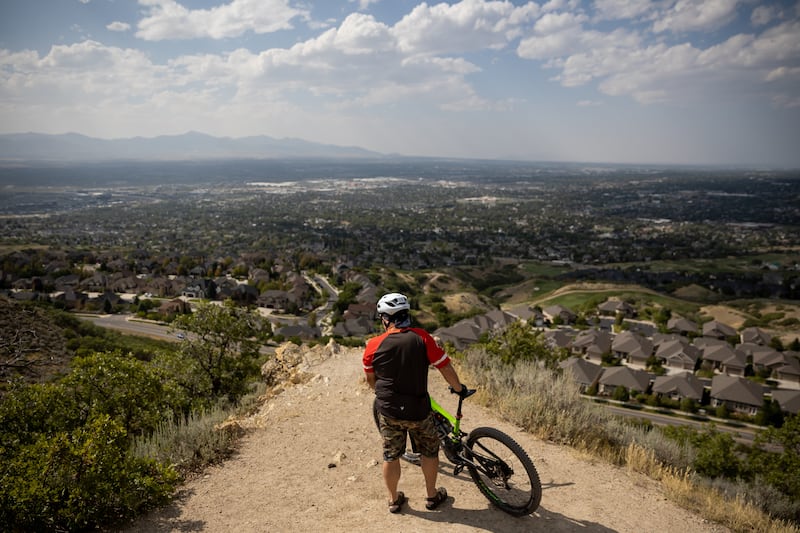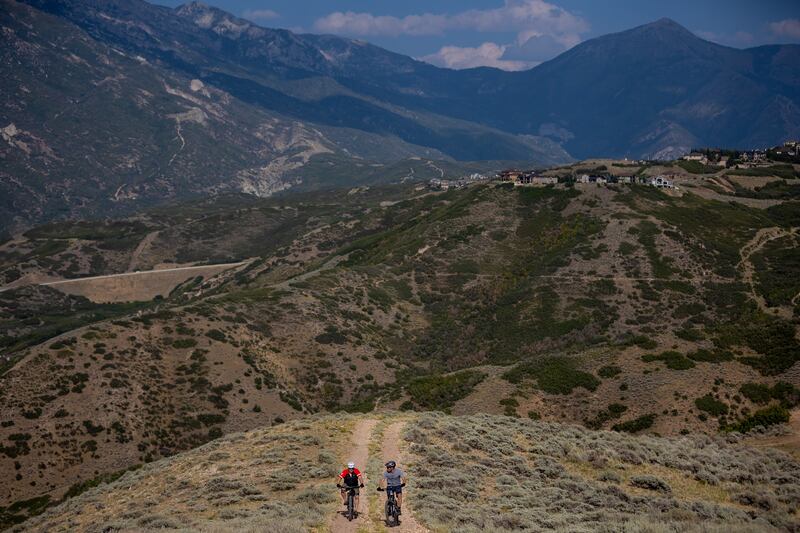Draper Mayor Troy Walker was slightly out of breath after pedaling his e-bike about nine miles up some 2,200 feet of steep, winding dirt trails.
He stopped at an overlook with sweeping views of his city, a bustling suburb about 20 miles south of Salt Lake City. Below, a steady stream of cars appearing miniature in the distance zoomed up and down I-15, the freeway that acts as Utah’s main transportation artery.
To the east of I-15, Draper neighborhoods span all the way up the foothills, right to the edges of the trail system that Walker had just ridden up in Corner Canyon. It’s the largest swath of open space and trails along the Wasatch Front, with more than 117 miles of trails and over 4,500 acres of preserved foothills. It’s a busy but vast, unpaved trail system that Walker, an avid mountain biker, rides frequently, and he jumps at the chance to show it off to visitors.

From the overlook, also visible below is something Walker — who’s on the tail end of his second term as mayor and is running for a third term unopposed — has wanted out of the city for a long, long time. Even before he was mayor.
The Utah State Prison. With its chain-link fences, drab buildings, barbed wire climb guards and some 4,300 inmates.
The prison’s campus has locked up over 600 acres of Draper land for 60 years.
“It’s been one of my main goals and focus,” Walker said, looking down at the sprawling complex. “It’s an amazing piece of property to have available in a perfectly great location.”

When the prison was built in 1951, the once-remote Draper land was a better alternative than its previous home, what’s now Salt Lake City’s Sugar House Park. But since then, the once-rural town has grown into one of the more desirable (and expensive) suburbs along the Wasatch Front.
Large mountainside houses speckle the foothills. Their proximity to hiking and biking treasures like Corner Canyon make Draper an appealing place, both for home-grown Utahns and for out-of-state transplants attracted to Utah for both its recreational and job opportunities.
The city’s foothills sit near the Point of the Mountain, where I-15 wraps around the mountain connecting Salt Lake County, Utah’s most populous, with Utah County, home to the state’s tech hub known as Silicon Slopes. It’s a core area for growth in Utah, which over the last decade has been one of the most rapidly growing states in the nation.

But there, in the middle of all that growth, sits the prison.
“Yeah,” Walker said, reflecting on all the years it’s taken to get it moved. “I think it’s taken too long.”
The mayor acknowledged, though, for a move so big with such drastic implications for not just Draper’s future, but for the community that would house the prison next, the years of public debate and planning were probably warranted.
“Nothing worth doing is easy,” he said.
But next year, Walker will get what he’s wanted.
The prison is set to move to a new remote location — west of the Salt Lake City International Airport — when construction for a new, nearly $1 billion facility finishes next year. It’s slated to begin taking inmates in June 2022. The move will happen about a decade after Utah leaders began studying whether relocating the prison to free up the prime Draper real estate for development made financial sense.
Utah’s leaders ultimately decided yes, it absolutely makes financial sense.
When the relocation authority recommended the move in 2014, it estimated the annual economic benefit from developing the prison property would be $1.8 billion, with state and local taxes adding up to $95 million each year.
Today, preliminary figures gleaned by the Point of the Mountain State Land Authority in partnership with the University of Utah’s Kem C. Gardner Policy Institute estimate an initial public and private investment of about $200 million — along with billions more in anticipated investment from the private sector — would generate about $6.9 billion in GDP for the state, $4.7 billion in personal income and up to 47,000 jobs.
The prospect of what that land could become fueled development and political pressures that grew powerful enough to move the prison yet again. It wasn’t without a painful siting process, years and years of debate and plenty of controversy — not to mention the now nearly $1 billion alone to build a new prison from scratch. But then-Gov. Gary Herbert and the Utah Legislature, at the time led by House Speaker Greg Hughes, R-Draper, and Senate President Wayne Niederhauser, R-Sandy, approved and funded the move.
Now all that land is about to open up. And for years, Utah leaders have been planning how to build on it.
Walker can’t wait.
“It’s just great to see it come together and finally see it really come to fruition,” he said, “and be what we all hoped it would be.”

What is The Point?
The players in charge of overseeing the Draper prison site’s development have called it a “once-in-a-generation” opportunity. One that’s “unprecedented” and “unlike anything, anywhere else” in the world.
“It’s incredibly unique,” Brian Jencek, of the San Francisco-based planning firm HOK that was retained by the state as a consultant on forming the project’s vision, told lawmakers in 2018.
“I think that you’re on to something incredibly powerful here. I know of no other area where so many people are concentrated in such a tight corridor that has, suddenly, such a large available piece of land,” he said. “What major American — even international city — of this density has such a large, contiguous developable site at the center? It just doesn’t happen.”
The grand vision for the former prison site is, so far, a master-planned “complete community,” or Utah’s first “15-minute city” that would contain everything a person needs to live and thrive within a 15-minute walk from its heart. The plans detail a “vibrant mix” of retail, entertainment, schools, high-quality workplaces, restaurants and recreation.
Its visionaries have named it The Point. It came into sharper focus this summer, when the Point of the Mountain State Land Authority board, the body tasked with master planning the project, unanimously approved the plan framework.
The Point is envisioned as a “model live-work community,” the plans state, intended to show the nation and the world it’s possible to house more people without traffic gridlock. The plans call for about 40% of its developable land to be devoted to housing, or an estimated 7,400 residential units. The rest would be for offices, retail, mixed uses, and an “innovation center” with a focus on schools, education and business development.
The plan currently contemplates up to 15,000 residents and 40,000 workers.
Last year, then-Lt. Gov Spencer Cox, who co-chaired the state panel tasked with redeveloping the former prison site, challenged state leaders to “think big,” saying “there really isn’t anything like this in the world right now.” He called it a “multigenerational opportunity,” and one that could put Utah on the national map, perhaps with its own world-class monument like Paris’ Eiffel Tower or Seattle’s Space Needle.
If Walker had his way, he’d love to see “some major league sports entertainment center” at the heart of The Point. “If I had my dream, it would be the NFL,” he said. “But I’d take baseball.”
To the mayor, when The Point comes to fruition, he believes it will truly put his city on the world map.
“It can be a real world-class spot,” he said. “I hope it will be. I think it has all the potential to be.”
And the piece of Draper that he thinks already puts the Utah suburb on the national map — Corner Canyon — fits right into the plans, Walker said.
What does The Point mean for Draper’s future?
Walker said The Point could put Draper “up there with the great cities around the world,” pointing to places like Denver with high-quality jobs and housing near “amazing” recreational opportunities.
“This is our economic future, without a doubt,” he said.
To Walker, one of the most exciting elements of The Point is how it would connect directly into Draper’s east-side trail system, as well as other trail systems in Salt Lake County.
A “river to range” corridor would link the entire community to the Jordan River Parkway to the west and across I-15 into the Wasatch foothills to the east, including Corner Canyon. The plans include a web of 140 acres of open, walkable green spaces threaded throughout the entire property, allowing people to move about without ever using a road.

“This is going to draw people,” Walker said of Corner Canyon. “I don’t think there’s another city in the country that owns as much open space, anywhere.”
After all, it’s often hiking and biking opportunities that draw people to the West and Utah in the first place, he said.
But a frequent complaint and question that continues to swirl around The Point is whether the area — with the Point of the Mountain already known for traffic gridlock during rush hour — can even handle more growth.
And it’s not just I-15 that’s already congested. Corner Canyon’s trail system has become increasingly crowded as it has grown in popularity.
“Well, we’re not going to stop the growth,” Walker said. “So we really can’t have a no growth discussion.”
The Point’s plans focus on building “from the ground up” to ensure “car is not king” when it comes to transportation, he said.
In years and decades to come, Walker said it’s likely Corner Canyon will see more hiking and biking trails, which also connect into the Traverse Mountain trail system in neighboring Lehi, a booming area of its own. Like Walker, Lehi Mayor Mark Johnson sees The Point as an “awesome” project for his city’s future, with elements that he said should help take more cars off the road.
“I can tell you right now, we actually have people who ride bikes on the trail systems to their employment from their homes every single day and back,” Johnson said. “So these trails play a pretty important part in removing vehicles off the road.”
Walker, gripping his own Specialized e-bike’s handlebars, said he’s convinced e-bikes are the future. “They’re changing the world,” he said. “People can use them to get around. And I think the way we build this place, 90% of the people are going to live there and work there, they’re going to stay there a lot.”
For those commuting in, “it can’t be by car,” Walker said, hence the heavy focus on transit included in The Point’s framework.
“We’ve got to have world-class, in-and-out transit,” Walker said. “We’ve got to do the transit right. We’ve got to do the roads right. And we’ve got to make it so people can get in and out without driving.”
Walker brushes aside perpetual criticism that money and developers drove the prison’s relocation and the property’s redevelopment. He said the project has deserved — and seen — an extraordinary amount of public input. And that the process is ongoing.
“But, you know, you have to have developers. Developers get a bad name, but they’re the ones that build stuff and they don’t do it for free,” Walker said. “They’ve got to make money out of it. So hopefully we can provide a way that when they do build it, it benefits everyone.”



